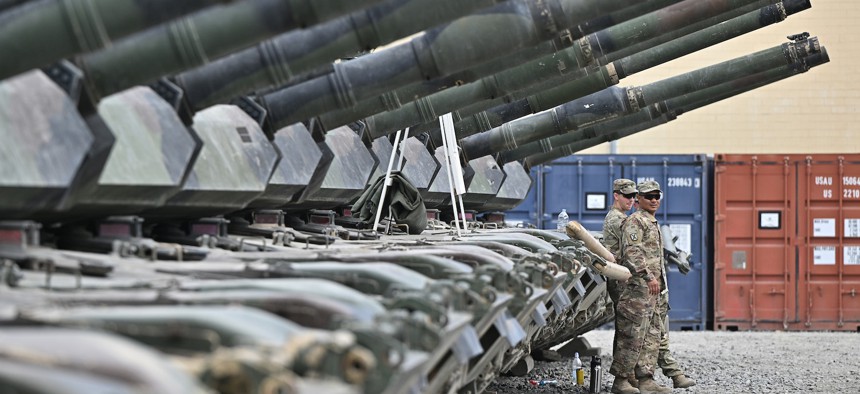
Soldiers of the US-Army 1st Raider Brigade stand in front of tanks at the Grafenwoehr training grounds on July 13, 2022 near Grafenwoehr, Germany. Getty Images / Lennart Preiss
Ukraine wants West's help in training NCOs and officers
U.S. and allies have already trained some 300 Ukrainian company commanders.
The U.S. and Western allies have increased their training of Ukrainian officers and noncommissioned officers, at Ukraine’s request, and may begin training the trainers as well, military officers involved in the effort said Tuesday.
Ukrainian military leaders’ “priority for the last eight months has been leadership training,” said Canadian Brigadier-General Mason Stalker, the deputy commanding general for Security Assistance Group Ukraine, the group responsible for coordinating international military aid to the country. Now, Stalker said, leaders have asked western countries to train the trainers.
“They know that they need to have professional instructors and a professional instructor corps to help continue education and training,” he said.
The U.S. and allies have trained 89,090 Ukrainian troops across 88 training locations so far, with 7,800 more troops in training now, according to a slide shared Tuesday at the annual AUSA conference in Washington.
Of those troops, the countries supporting Ukraine have trained 3,800 leaders. The total includes 2,600 squad commanders, 540 platoon commanders, 300 company commanders, and 40 platoon and company sergeants. An additional 520 leaders are in training.
Ukraine has specifically prioritized training its non-commissioned corps, Stalker added. “They understand the value that backbone will bring,” he said.
Experts have said Ukraine has a significant shortage of trained leaders. British think-tank RUSI, which has conducted research within Ukraine, previously identified a lack of a staff capacity at the battalion and brigade level as hampering Ukraine’s performance on the battlefield. This is partly due to the rapid expansion of Ukraine’s army, which resulted in more units than there are experienced staff officers.
The request to train the trainers comes amid concerns about weakening support for Ukraine in the West. While a majority of members of the United States Congress support aid for Ukraine, a small but vocal minority of Republicans were successful in having Ukraine aid excluded from the short-term government funding package passed in September.
As Ukraine ramps up training, it’s increasingly interested in synthetic or virtual training that combines digitally created situations with realistic controls representing those found on military vehicles.
“We're seeing a lot of thirst by our Ukrainian partners to use those environments where they can, particularly outside of Ukraine,” Stalker said.
Trainers also said they’ve learned from the Ukrainians.
Col. Bryan Harris, commander of the 2nd Armored Brigade Combat Team, helped train Ukrainians to launch combined operations, including coordinating between Bradley infantry fighting vehicles and M109 Paladin howitzers.
A Ukrainian brigade commander training under Harris had “nine or so TVs in the back of his command vehicle, and they were all [to watch feeds from] drones,” he said.
By contrast, Harris had just four screens in his command vehicle. For the Ukrainian forces trained by the U.S., “every squad had their own drone,” he said.
Lt. Col. Seth Barrett, commander of the unit that taught Ukraine to operate Patriot anti-missile batteries, said Ukrainian troops’ ability to quickly master a foreign system in a different language made him reassess what the U.S. might expect from its own soldiers.
The U.S. may want to ramp up the “intensity of our professional military education, what we're asking from our non-commissioned officers,” said Barrett.


